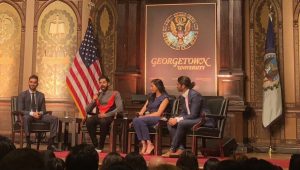The International Cricket Council (ICC) Men’s Cricket World Cup kicked off this October in India, drawing millions of fans to watch another competition between the world’s cricket powerhouses.
Despite being the world’s second-most-watched sport, cricket has yet to gain popularity in the United States, including at Georgetown. The university cricket community, however, is booming despite the sport’s lack of national popularity. Spurred by World Cup excitement, the sport is fostering community among South Asian Hoyas.
Shobhit Kumar (BGA ’24), vice president of the Georgetown University Cricket Club (GUCC) and an international student from New Zealand, views cricket as intimately tied to his childhood, but did not expect to find the same passion among others at Georgetown. “Cricket is about as niche as you can get in the world of sports in the U.S.,” he said.
But during his sophomore year, he stumbled upon the Georgetown cricket community. From discussing favorite players to playing the sport together, cricket connects individuals with a common love for the sport. “Moments like that are really helpful to remind me that there is a community here that I am a part of,” Kumar said.
Noteworthy within the community is the prominence of South Asian members. Despite being introduced to South Asian nations through British colonialism, cricket is no longer viewed as a mere colonial legacy and has been reclaimed as a key part of South Asian identity and culture. This year, five of the 10 teams competing in the World Cup are South Asian nations: Afghanistan, Bangladesh, India, Pakistan, and Sri Lanka.
The sport’s greatest rivalry is between two South Asian nations: India and Pakistan. On Oct. 14, the two nations faced off in a match, garnering over 100 million concurrent viewers—and some here at Georgetown, too.
The Georgetown South Asian Society (SAS), South Asian Policy Research Initiative (SAPRI), Asian American Student Association, and GUCC co-sponsored a watch party for the match. Students gathered early Sunday morning to watch the high-energy matchup.
“The HFSC came alive with excitement,” Rai Hasen (SFS ’27), a freshman representative for SAS who helped coordinate the event, wrote to the Voice.
Open to all fans, and even first-time spectators, of cricket, the watch party illustrates cricket’s ability to create a welcoming space. “It was a fantastic chance for undergrads to mingle,” Hasen added.
The event wasn’t just for long-time fans, either. For Indian American and Pakistani American newcomers to the sport, the event served as an opportunity to dive deeper into their culture.
For older cricket fans, the rivalry is rigid: fans on either side cheer not only for their team’s success but also for their rival’s failure. But for the younger generation, it seems to be less divisive. “I would rather have Pakistan win the World Cup than Australia or England,” Kumar said, despite his Indian heritage. “I feel more of a sense of brotherhood with my friends from Pakistan.”
Oftentimes, a shared heritage on its own is not enough to kickstart a friendship. A mutual passion for cricket deepens relationships, introducing South Asians to a subset of the community with which they have more in common. Kumar recalled several friendships that deepened over early-morning watch parties and playful banter about the India-Pakistan rivalry.
With most games happening across major time zone differences, the bonding experience is even more intense. “The fact that I had friends to get up with at 4:30 a.m. is just so cool,” Kumar said. Even the struggle to watch the World Cup has fostered friendships. The matches can only be streamed through ESPN+, and for those without a subscription, “anyone watching a match on it automatically becomes a friend—an unspoken rule in the cricket fraternity,” Hasen said.
However, there remains room for growth in the cricket community. Kumar wants to hold more cricket events that focus on South Asian nations beyond just India and Pakistan. While current engagement at Georgetown mostly centers around their rivalry, cricket’s impact extends to many other South Asian countries. Kumar hopes that cricket can be a space for all South Asians, even those from less-represented nations of the subcontinent.
“I want other South Asians … to still feel like they can attend cricket events and that it is a place for them,” he said. “Because representation matters.”
The importance of this representation is evident not only in the rapid development of the campus cricket community but also in its impact on current and future Hoyas. High school students often message the GUCC Instagram account asking about cricket life at Georgetown, according to Kumar. For some, the existence of a cricket community is even a factor in their college decision. In the spring of 2022, GUCC went from having casual practices on Copley Lawn to facing off in a match against Georgetown’s Qatar campus in Doha. And the momentum continued to build.
On Oct. 29, GUCC played a match against the Embassy of India—and won by five wickets. The winning run was even scored by a Pakistani player, Arhum Rashedi (MSB ’24), who was also awarded ‘Man of the Match.’
“GUCC’s recent triumph against the Indian Embassy demonstrates that we’re breaking down political barriers and expanding our outreach,” Hasen wrote to the Voice. Despite students’ differing heritages and the historic political and athletic rivalry between Pakistan and India, players were united around a common South Asian identity.
As cricket grows, it offers more spaces for students to engage with something meaningful to them, a feat especially important for South Asian students for whom cricket is an integral part of their culture. “With the T20 Cricket World Cup heading to the USA in 2024, it’s set to gain even more traction and foster cross-cultural connections on campus,” Hasen wrote. The Georgetown cricket community is still young, and its future is bright. In Kumar’s words, “even if it’s not necessarily my home, it’s somewhere where I can be at home.”





